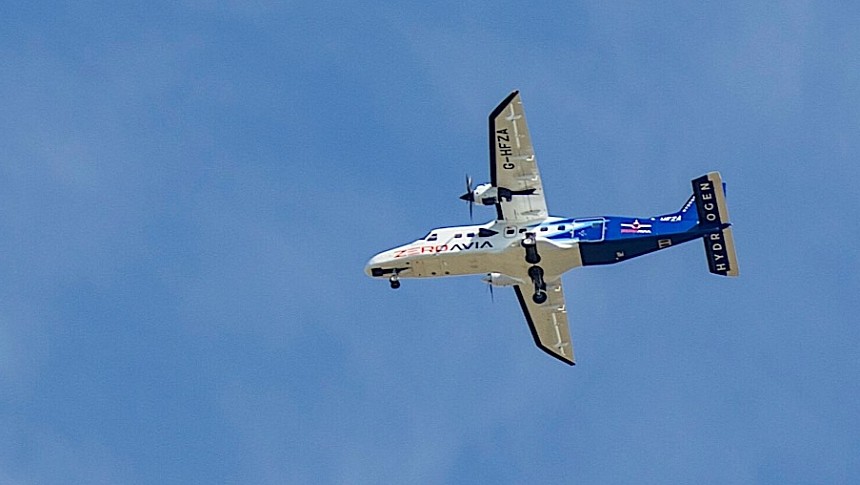Although it may sound simple to do, swapping standard aircraft engines for ones running on hydrogen is not an easy task. And a company called ZeroAvia can attest to that.
The name may not mean all that much at the moment, but if its idea of retrofitting small and medium passenger planes with hydrogen engines catches, it may become very important for the industry.
The company is currently knee-deep testing the idea. It took a Dornier 228 passenger aircraft, which is usually powered by a pair of Honeywell turboprop engines, and gifted it with pieces of hardware that run on the benign fuel and are known as the ZA600.
The plane has been flying for testing purposes for a while now over in the UK, with the last test we knew of taking place in May, when the special Dornier reached a record altitude: 4,000 feet (1,219 meters).
That record was shattered this week, when the plane took to the sky and stayed up there for some 20 minutes. During this time, it managed to climb to 5,000 feet (1,524 meters), which is more or less a mile high.
ZeroAvia says testing of the plane will continue at an accelerated pace, with the final flight of this phase of testing procedures expected to take place in the coming days. That one is meant to assess the maximum endurance of the ZA600 hydrogen powertrain.
The exact specs of the technology are not publicly known, except for the fact it comes with an output of 600 kW, but the company behind it says when fully operational (that should happen around 2025), the ZA600 could help a plane the likes of the Dornier 228 fly for as much as 345 miles (555 km).
Small planes are not the only ones targeted by the British-American aviation company. By 2027, it expects the hydrogen engines it makes to be able to power aircraft with as much as 80 people on board for distances as large as 1,150 miles (1,852 km).
The tech capabilities will increase even further in 2029, when it's expected to be mature enough to make it into 200-passenger aircraft and take them to distances of up to 2,300 miles (3,700 km).
The hydrogen engine's full capabilities should be reached in 2040, when planes with in excess of 200 seats should be able to fly long-haul flights of up to 5,700 miles (9,200 km) while not damaging the environment in the slightest.
At the moment ZeroAvia's dreams seem to be just that, dreams, as to our knowledge no major airline has expressed interest in making hydrogen planes powered by the ZA600 part of their fleets.
Seeing how the world weather is acting up these days, one can only that changes fast though.
The company is currently knee-deep testing the idea. It took a Dornier 228 passenger aircraft, which is usually powered by a pair of Honeywell turboprop engines, and gifted it with pieces of hardware that run on the benign fuel and are known as the ZA600.
The plane has been flying for testing purposes for a while now over in the UK, with the last test we knew of taking place in May, when the special Dornier reached a record altitude: 4,000 feet (1,219 meters).
That record was shattered this week, when the plane took to the sky and stayed up there for some 20 minutes. During this time, it managed to climb to 5,000 feet (1,524 meters), which is more or less a mile high.
ZeroAvia says testing of the plane will continue at an accelerated pace, with the final flight of this phase of testing procedures expected to take place in the coming days. That one is meant to assess the maximum endurance of the ZA600 hydrogen powertrain.
The exact specs of the technology are not publicly known, except for the fact it comes with an output of 600 kW, but the company behind it says when fully operational (that should happen around 2025), the ZA600 could help a plane the likes of the Dornier 228 fly for as much as 345 miles (555 km).
Small planes are not the only ones targeted by the British-American aviation company. By 2027, it expects the hydrogen engines it makes to be able to power aircraft with as much as 80 people on board for distances as large as 1,150 miles (1,852 km).
The tech capabilities will increase even further in 2029, when it's expected to be mature enough to make it into 200-passenger aircraft and take them to distances of up to 2,300 miles (3,700 km).
The hydrogen engine's full capabilities should be reached in 2040, when planes with in excess of 200 seats should be able to fly long-haul flights of up to 5,700 miles (9,200 km) while not damaging the environment in the slightest.
At the moment ZeroAvia's dreams seem to be just that, dreams, as to our knowledge no major airline has expressed interest in making hydrogen planes powered by the ZA600 part of their fleets.
Seeing how the world weather is acting up these days, one can only that changes fast though.






